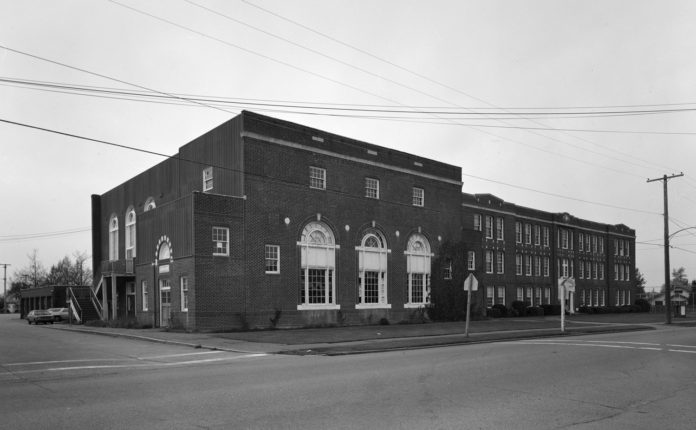For more than three generations, this school building occupied center stage in the community of Enumclaw. And for good reason – the high school and later junior high located at 2222 Porter Street was by far the largest building in town, and a focus of community pride. The auditorium alone seated 1,312 and was Enumclaw’s primary performance facility for nearly 50 years. The demolition of this architecturally significant structure in 1986 is still regretted as a tragic choice by those generations who walked its hallowed halls.
The growth of Enumclaw schools through consolidation with small, surrounding schools caused the district to grow rapidly – from 162 students in 1905 to 725 in 1921. This property measured 5.44 acres on a triangular block that was purchased from the Catholic Diocese for $5,000 in 1920. The cemetery which previously occupied the property was relocated.
The school was erected in 1921 in a ceremony attended by the U.S. Commission of Education, the State Superintendent, and local dignitaries. Further growth in the 1920s and 1930s required three expansions of the original building. Initially, it was a high school only, but a new wing was added in 1928 next to Kibler Ave. to house junior high students. A bus garage on the south side next to Hillcrest Ave. was also built. During the depths of the Great Depression with Federal assistance, a second remodel in 1935 added the auditorium, cafeteria, gymnasium, boys’ and girls’ showers plus locker rooms. In 1938, a small three-story appendage was added west of the 1928 wing.
Yet, the district continued to grow so a modern high school was constructed on Semanski Street in 1963. This school then became the junior high comprised of seventh, eighth, and ninth grades. Freshmen moved to the new high school in Sept. 1969, and in 1985, a new junior high was built near the high school on Semanski, and this building was abandoned.
The structure was designed by the well-known architect, Harlan Thomas in the Colonial Revival style with additions by William Mallis. Peter Woeck of Seattle was selected as the prime contractor. According to the Historic American Building Survey (HABS) completed by the Dept. of the Interior in 1986, the building was “the only historic school building remaining in Enumclaw. All other remnants of Enumclaw’s educational heritage have been lost.” Carolyn Foos of the Enumclaw Arts Council and Mark Brack of the Washington Office of Archeology and Historic Preservation wrote a report to place it on the National Register, but nothing came of those efforts.
There was a groundswell of community support to save the school, as other districts had done with their historic structures. Even so, the school board’s decision was made to tear it down so it was demolished in 1986. This photo looking northwest from the corner of Porter and Battersby Ave. was taken in April 1986 by Richard and Carolyn Uhlhorn and comes courtesy of HABS. Seventeen other photos of the exterior and interior further preserve its memory.
There remains however one unanswered mystery about the school. Many claim the building included a swimming pool where a student drowned, so it was closed down and covered over by the girls’ gymnasium. This story has passed down and been circulated for years, yet no mention of the pool is made in any architectural or historic documents. The alleged event has achieved the status of an urban legend, though no contemporary newspaper story or name of the deceased student has ever been produced. If the tragedy had occurred, then surely, the Enumclaw Courier-Herald would have reported on it. So, a call goes out to anyone who can clear up the question by providing factual documentation or newspaper articles of the pool’s existence, the date of the drowning, the name of the fallen student, or an obituary.
Over the next two weeks, this column will highlight two businesses, Anderson’s Confectionary and Mrs. Lofthus’ store that were established nearby to serve the needs of a large number of students, teachers, administrators, and residents who populated the neighborhood.







